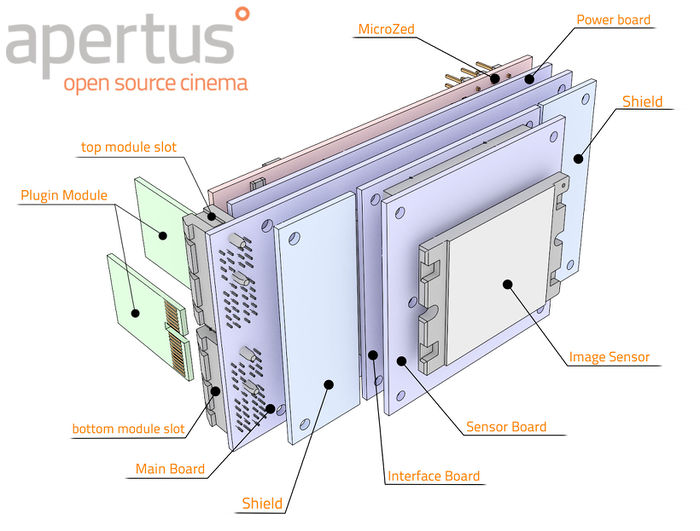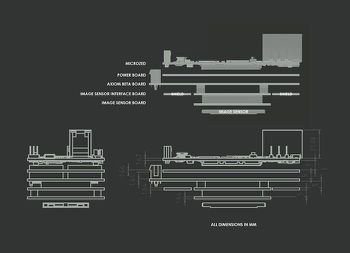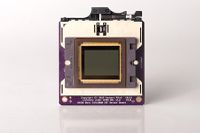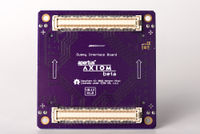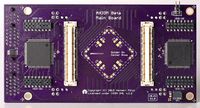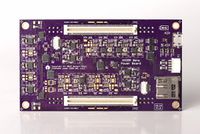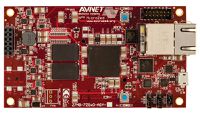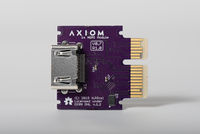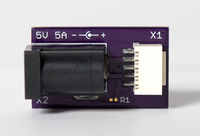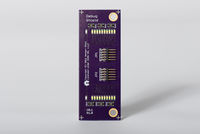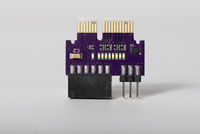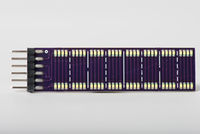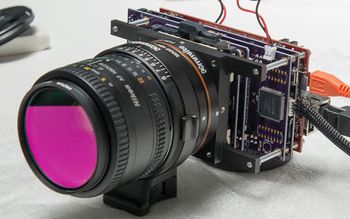Difference between revisions of "AXIOM Beta/Camera Structure"
m |
m |
||
| Line 45: | Line 45: | ||
==Main PCBs in Detail== | ==Main PCBs in Detail== | ||
The AXIOM Beta comprises five printed circuit boards (PCBs) | The AXIOM Beta comprises five printed circuit boards (PCBs) | ||
In rare cases users may want to build the camera and or its components themselves - see [[AXIOM_Beta/Prices]] for cost estimates. Wwe can either supply all the individual components or the relevant files with a view to a user sourcing unpopulated PCBs directly from the manufacturer. In any event make contact and we'll provide guidance. | |||
Revision as of 10:03, 15 November 2017
1 Camera Structure
“The hardware design of the AXIOM Beta was kept simple at first, purely addressing problems discovered with the AXIOM Alpha. In the beginning we had intended to design the camera around a single board on top of an off-the-shelf FPGA/system-on-chip development board: the MicroZed™, but as a result of field testing and together with feedback gathered from the community we agreed to make it far more powerful by devising a more complex stack of boards where each layer is dedicated to specific functions.” - Sebastian Pichelhofer.
2 AXIOM Beta PCB Stack Layout
Version 4:
Note: All dimensions are not final. Work in progress...
File:PCB Stack Concept V03 02.pdf
Onshape CAD workfile here
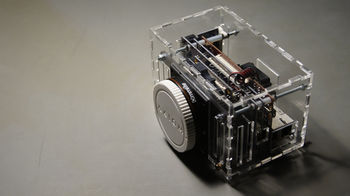
3 Skeleton and Enclosure
>>>> TODO Overview text required (picture ideally)
Skeleton and Skeleton Footplate: https://github.com/apertus-open-source-cinema/beta-hardware/tree/master/Enclosure/Skeleton_E-mount
Onshape PCB Stack and Skeleton Assembly: https://cad.onshape.com/documents/58bd498285673a104722aacd/w/466b8105bf6807b3f4f50b6c/e/b33cc7b3cc3cc5eebd5c2ae6
For enclosures (development pending) see - AXIOM_Beta/Enclosures
4 Main PCBs in Detail
The AXIOM Beta comprises five printed circuit boards (PCBs)
In rare cases users may want to build the camera and or its components themselves - see AXIOM_Beta/Prices for cost estimates. Wwe can either supply all the individual components or the relevant files with a view to a user sourcing unpopulated PCBs directly from the manufacturer. In any event make contact and we'll provide guidance.
| AXIOM Beta PCB's | ||
|---|---|---|
| Sensor Board | The Beta CMV12K ZIF Sensor Board hosts the heart of every cinema camera - the (CMOS) image sensor. apertus° offered three different sensor options during the crowd funding campaign; Super35, Super16 and 4/3rds, and as almost 90% of the backers opted for the Super35 sensor its respective module was developed first. The camera uses the ams Sensors Belgium CMV12000. Note: The ZIF (Zero insertion force) socket is useful for developers as it allows for the sensors removal at the turn of a lever (zero force). The AXIOM Beta II: Production Ready camera hosts the Beta CMV12K THT Sensor Board. THT (Through hole tech) is suited to applications where the sensor-front-end won't be removed regularly. As such the THT Sensor Board requires that care is taken not to bend the sensor pins on insertion. | |
| Interface Board | The Beta Interface Dummy Board acts as a bridge between the image sensor board and the rest of the camera. It converts communication between the aforementioned components to a standard protocol so that almost any image sensor that becomes available in the future can be used with the AXIOM Beta without changing the rest of the hardware. If AXIOM users felt that 8K was in demand they would simply swap the sensor board for one capable of capturing images in the desired resolution. | |
| Beta Main Board | The Beta Main Board is the equivalent of a PC's motherboard. It hosts two external medium-speed shield connectors and two high-speed plugin module slot connectors. These act as a central switch for defining where data captured by the sensor and other interfaces gets routed to inside the hardware. In this regard, all specifics can be dynamically reconfigured in software opening up a lot of new possibilities such as adding shields for audio recording, genlock, timecode, remote control protocols or integrating new codecs and image processing inside the FPGA. In the centre of the main board a 'solder-on' area has been incorporated, this will for example host chips capable of sensing the camera's orientation and acceleration (the same chips used to stabilise quadcopters and track head movements in VR headsets). Being situated directly behind the image sensor centre means that these sensors are ideally positioned to supply data for image stabilisation or metadata about the camera’s orientation and movement during a shot. | |
| Beta Power Board |
Finally, the Beta Power Board PCB, the last board in the stack before the MicroZed™, generates all the different supply voltages for the chips and logic on the other PCB’s inside the camera. It also monitors currents so that it can estimate remaining power based on the recorded consumption. In the current revision of the camera a predefined set of supply voltages matching the current application with the rest of the camera have been generated, in the future however, it will be possible for users to dynamically reconfigure voltages according to their needs through the camera’s software. | |
| MicroZed |
The AES-Z7MB-7Z020-SOM-G MicroZed™ is a development board based on the Xilinx Zynq®-7000 All Programmable SoC (System-on-a-Chip). It can be used as both a stand-alone development board for SoC experimentation or in a product like the AXIOM Beta. | |
5 Plugin Modules and Shields
The AXIOM Beta has 2 medium speed IO interfaces to be used in conjunction with "shields".
- One 200Mbit/s shield interface.
- One 1Gbit/s shield interface.
Note: Shields are not hot plug-able.
There are 2 high speed IO interfaces where "plugin modules" can be hot plugged.
- 6.2Gbit/s each:
- 6 ✕ 950Mbit/s
- 500MBit/s GPIO
- Two modules can be combined in one 12.4 Gbit/s double height module.
- Hot pluggable.
- 2x PCIe connectors (not using PCIe signaling)
| AXIOM Beta Plugin Modules and Shields | ||
|---|---|---|
| HDMI Plugin Module | The Beta HDMI Plugin Module ... | |
| Power Adapter | The Beta Power Adapter Board ... | |
| Debug Shield | The Beta Debug Shield ... | |
| 1x PMOD Plugin Module |
The Beta 1x PMOD Plugin Module ... | |
| 3x PMOD Plugin Module | [[File:|thumb|none|200px|....]] | |
| PMOD LED Matrix Debug Module |
The PMOD LED Matrix Debug Module ... | |
| 4K HDMI Plugin Module | File:... ... |
The 4K HDMI Plugin Module ... |
| AXIOM Beta Planned Technical Specifications | |
|---|---|
| Image Sensor | 3 different swappable sensor modules planned |
| Modules and Shields | Single HDMI Full HD (4:4:4) output at up to 60 FPS |
| 3x HDMI Full HD (4:4:4) output at up to 60 FPS each (in development) | |
| 3x PMOD debug module | |
| LED matrix debug module | |
| Genlock, Trigger, Timecode, LANC shields (in development) | |
| 4K Displayport/HDMI (in development) | |
| Features | 4K RAW experimental HDMI/Displayport outputs over 1080p60 |
| Remote Control | Change/access all camera functions from smartphone , tablet, laptop (Web GUI, Serial console, SSH) and AXIOM Remote |
| Power Management | Voltage, current, temperatures |
| Wide input voltage range (5-40V) | |
| Motion Tracking | 3D Accelerometer, 3D magnetometer and 3D gyroscope e.g. for image stabilization |
| Swappable Lens Mounts | Passive E-mount plus adapters for: Passive Nikon F-Mount; passive Canon EF Mount; passive M4/3 Mount (future addition) |
| Operating System | Embedded Linux (Arch Linux) |
| Hardware Architecture | Xilinx Zynq 7020 based MicroZed |
| Image Processing | Look-Up-Tables (LUTs), matrix color conversion, Fixed Pattern Noise (FPN) compensation, false color display, overlays, dead pixel compensation |
Note: As the AXIOM Beta is currently under heavy development the above table describes goals not the current state of development.
6 Functions
Recording Options
The AXIOM Beta currently utilizes external third-party recorders for capturing moving images. A number of different products from different brands can record the HDMI signal from the AXIOM Beta and store the video in Prores or DNxHD. There are plans for enabling AXIOM Beta internal recording to solid state storage in the future however. In particular this is a requirement for writing high speed video as the Beta sensor is capable of capturing moving images at up to 300 FPS in full 4K resolution.
Operating System
Since the camera is running Linux, you have a full operating system at your disposal. This means any 3rd party peripherals like USB drives or wireless adapters should work out of the box. Standard protocols like SSH/FTP/SCP/etc. as well as Graphical User Interfaces via HTTP can be used to interface with the camera from computers and most mobile devices.
Target Audience
With a clear initial target audience and application which focuses on early adopters and developers, the AXIOM Beta I: Developer Kit is aimed at those who want to actively participate in and contribute towards development. As the camera matures, the target audience will expand towards professional applications and end users. Those professional applications are typically, but not limited to, any environment suited to compact form-factor, high performance cameras e.g. aerial recording, car mounting, gimbals, cranes, jibs, cable cams, action cams, handhelds etc, but the Beta has attracted interest from a wide range of disciplines, such as the astronomy, industrial and scientific fields, on account of a user's being able to easily adapt the camera to the specific project's requirements or their being able to process/analyse images directly inside the camera instead of on a remote computer. With a small form factor, the AXIOM Beta is ideally suited to environments where DSLRs are commonplace.
Pricing
The AXIOM Beta II has an expected retail price of €5990 (excl. VAT + Shipping). During crowd-funding we offered project backers and developers the opportunity to purchase the camera at cost €2300 (excl. VAT + Shipping). For a full breakdown of pricing for individual components see here.
Future
Whilst it's true to say that development is in the early stages, because of how it’s being designed to constantly evolve and improve, it's unlikely that there’ll ever be a “final” version of the camera. This means that even when the camera is at a stage where everything is fully working and shipped as a finished product there will still be scheduled improvements delivered in software or offered as optional hardware upgrades - thus establishing an ecosystem and hardware platform rather than a final product.
With the AXIOM project, users are being given more control over the configuration of their camera so that it can be adjusted to their own needs or liking, and thanks to the camera’s construction there really is no limit to what’s possible. The role of apertus° is to assist the filmmaking community with support in this regard and to provide a platform which simplifies configuration or conversion and to encourage community participation now and in the future.
“Unlike with previous camera manufacturers, everything we do is open to scrutiny from the outside world as all our schematics, source code and technical development processes are publicly accessible. We want our project development to be transparent and open to the ideas contributed by users.” - Sebastian Pichelhofer.
